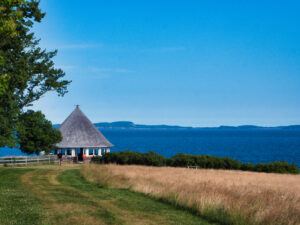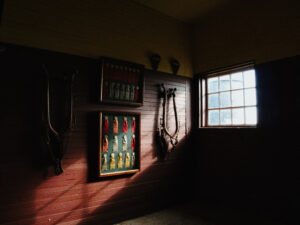
The operators of Ministers Island say without additional funding they will have to relinquish control to the province, but Holt says all the funding is already up.
A lot has been made of ‘nation building’ projects as of late and the fate of the site tied to Canada’s original ‘nation-building’ project is in the hands of the province, say the operators of Ministers Island.
The island–once home to Sir William Van Horne, American rail tycoon entrusted by Sir John A. Macdonald completed the Canadian Pacific Railway, uniting Canada’s newly united East and West coasts–is facing serious economic uncertainty. One that will likely mean relinquishing their 21-year control of operations on the island.
The operator has been very vocal about the financial situation, one it says threatens the livelihood and future of one of Saint Andrews premier attractions. So much noise in fact, Premier Holt was asked to comment on the situation at a meeting with reporters.
The organization said it is planning to turn the keys over to the province. In August, they will give the province six months notice, after that it will be the province in charge of the island and its attractions.

Recently, in a letter distributed to residents of Saint Andrews the Van Horne Estate on Ministers Island (VHEMI) alerted to a “significant issue regarding the future management of Ministers Island.”
It stated the organization have deemed themselves “no longer fiscally sustainable.”
“In absence of the province providing a fair and sustainable funding model, the Board of Directors has been forced to make the difficult decision of potentially relinquishing the 2008 lease with the province and dissolving the organization,” said VHEMI’s letter.
In an interview with The Courier, chair of the VHEMI board John Kershaw, said fair to them does not mean matching the funding to the commonly compared King’s Landing, but providing enough to ensure the longevity of the site.
“We’re comparing ourselves to King’s Landing, which is another historic site that has a comparable number of visitations per year,” said Kershaw. “I think they average about 30,000 and we peaked at around 26,000. They get $3.7 million a year and we get $100,000 a year.”
With that, VHEMI deemed $500,000 as a fair amount for the province to provide to the island to continue operations.
The letter urged residents concerned about the future of the island to write to the premier and Minister of Tourism, Heritage and Culture, Isabelle Thériault.
Read: Ministers Island operator faces uncertain future due to lack of funding
Holt said before the distribution of the letter–the province is working with operators and communities to ensure their access is maintained to historical sites like Ministers Island.
“The situation is really challenging with a number of our heritage sites,” said Holt.
“We renewed the funding that was provided in previous years at the same levels as Ministers Island received in the past.”
The comments came after several of the province’s outlets reported on the situation on the island.
“The funding committed was the funding received in previous years but their costs to operate is going up and that’s leaving them with shortfalls,” said Holt attributing the financial struggles of the operations to inflation.
She said the provincial government, at this time, does not have the additional money to invest into the province’s heritage sites.
“We’re working closely with operators that have chosen not to move forward with operations this year and communities,” said Holt.
She said the province is working with the community to ensure the sites stay open for the remainder of the summer, but Kershaw said it is unclear what that means. He said the province, as of now, has not elaborated on what that control would look like or how that might alter the current operations.
“We can ensure public access for them and figure out a way for the future viability and sustainability of some of those places that hold New Brunswick’s rich history and stories and we want to make sure they stay protected and preserved for future generations,” said Holt.

But what is the role of the province?
As laid out in the letter, the island was purchased by the Province of New Brunswick in 1977.
Since 2004, the VHEMI has operated the development and management of the island through a volunteer Board of Directors elected by community members. The organization has only one full-time employee and the day-to-day is run through seasonal guides and volunteers who do things like trail clean-ups after storms.
Kershaw said the VHEMI is a way for the voice of the surrounding community to be heard in a way that a provincially run organization would not be able to do.
In 2008, the VHEMI began a 25-year lease with the province. Provided with a mandate to operate the island, the lease also commits the province to fund the VHEMI but it did not specify what exact amount was to be provided.
Since then it has lobbied the provincial government for what they call “fair and sustainable” funding but have gained no ground. In their letter they outlined rising operational costs due to inflation should have been addressed and they find themselves in the situation they are in now due to those rising costs.
Kershaw is still unaware of how the province plans to operate the island.
“The officials in tourism have said, ‘No, you guys are the best model,’ but they don’t have the money to give us. So it’s a catch‑22, right?”
“We have said to them, if it’s not us, we just want to do what’s best for the park. We will help them transition to whatever governance model they think they want to move towards.”

Catch-22
“So we’re not asking for $3.7 million. We thought $500,000 would be fair and allow us to continue operating the island.”
He said their current financial outlook makes it difficult to get grants from outside the provincially provided finances. Grants often require the organization requesting funds to have a certain amount of financial by-in comparable to the funding provided, which according to Kershaw is not possible at this time given their current financial situation.
Although he said the operator has tried to seek funding outside of the province, VHEMI does not have enough money to leverage for investment.
“The first question they’ll always ask you is: well, how much money do you have to invest?”
Their answer has always been none.
“The additional money gives us the ability to go to other potential partners and say, we’ve got these ideas. Do you want to invest with us?”
Kershaw said the additional funding would allow for that answer to be yes.
Another complication he raised was the other potential partners like the federal government or private corporations interested often only want to be involved in specific projects and not the costs to operate.
A project like the barn on the island was provided with capital funding by Parks Canada, but he said the operating costs are what the VHEMI struggles to keep up with once they are completed.
As an example, the operator is interested in investing in refurbishing the creamery to be able to offer ice-cream or New Brunswick craft beer and wine to visitors on the island. To do that, it would need the capital available to put up for the grant.
“By comparison, the minister’s house is costing us $300,000 to restore just that building,” said Kershaw. “Now [the creamery restoration] might not cost us as much but that’s just the restoration of the building itself.”
For that project it received $100,000 from a private citizen, then with that they were able to go to the province to request the additional $200,000 required for completion now that they had the donation from the private citizen.
Fees only break even
“Going back to the fact that the numbers were dropping off that ties you to the revenues,” said Kershaw. “Meanwhile, your costs of operating, whether it be wages or gas or anything else is going up.”
He said the island saw 26,000 visitors in 2018 but after it started to decline. Notably before the pandemic, it took an even more dramatic cut to entry fee revenue. It has been clawing its way back up to 24,000 visitors in the last year, according to Kershaw.
He attributes the lack of visitors to the lack of financial returns. Given the stated difficulty in finding the funding for major projects he said it is not able to afford to refurbish existing infrastructure to offer attractions worth returning for.
“It would be a real shame, after 17 years of operating the island, for it to fold simply because of what is, in the grand scheme, not a large amount of money,” said Kershaw.
At this point the province has not told VHEMI what will happen after August, and the fate of Ministers Island remains uncertain.




